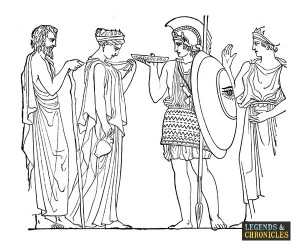Spartan Clothing and Dress
Both Spartan men and women dressed lightly and simply. The Spartan existence was that of a warrior who lived a basic farming lifestyle, therefore the dress worn by the Spartans reflected this, and was basic and functional for their environmental conditions.
Maybe the most flashy or extravagant feature of the Spartan wardrobe was their fondness for the deep crimson red colour. This colour however was a visual for war, the Spartans believe it was the least feminine colour and therefore wholly suited for war. the colour would also easily hide any blood let during battle so as not to the give the enemy any hope that the Spartans were wounded.
When not at war the Spartan dress code was similar to many of the Greek states at the time, if nothing else less Spartan and more simple.
The Spartan Tunic
The most common form of dress in the Spartan society was the Chiton or Doric, a type of tunic that made from a square piece of cloth, folded and wrapped around the Spartan and simply fastened with buttons, clips or pins.
The tunics of the Spartans would most than likely follow suit like their Greek counterparts, in summer linen would be the fabric of choice, either spun at home by Spartan women or helots, or purchased from fellow states. In winter the cool linen would most likely be replace with more suitably warm woollen tunics, although some other accounts list how the trend for linen and wool was more attached to the centuries rather than the seasons of a single year.
Spartan Footwear
Footwear for all Spartans would be a sandal or boot. The sandals would be constructed of leather and be simple in form, utilitarian in essence. Boots too would be simple in design, the Laconian boot was thought to be open toed, presumably to provide either greater movement or make the boot more suitable for the often warm temperatures.
The Spartan Cloak
The Spartan images we often see are those of the famous hoplites, wearing their crimson cloaks to battle. This point itself is the centre of much dispute, would the Spartan warrior have worn a cloak that could perhaps hinder him in battle? Many people believe the warriors of this state did wear the cloak to battle, of course when marching in colder regions, the cloak would offer valuable shelter for the warrior, even if the cloak could hinder them slightly in battle.
The two main cloaks worn by the Greeks and therefore the Spartans were the himation and chlamys. The Chlamys is the one you see depicted in images of the Spartan warriors and is worn over the shoulder, an accessory cloak to existing clothing. The himation on the other hand is more of the classic Greek wrap cloak you will have seen before, more flowing and billowy the himation cloak was worn with and without additional garments.
It’s thought that the Spartan chlamys cloak would have been worn in everyday use where required, deep crimson in colour, but the mystery still remains as to whether it was indeed worn to battle.
Spartan Women’s clothing
Spartan women would wear a chiton, like many Greek women, although the Spartan women were well known for their desire to wear less, possibly due to their upbringing and exercising nude. There were even Greek words and phrases that described how the Spartan women would dress, which would be much more risque than the rest of the Greek women of the time.
Spartan Men’s clothing
The men like the Spartan women would wear simple clothing when not in battle, a Chiton/Doric would be typical dress for a Spartan man. Boots and cloak would be worn if required, or a heavier tunic made from wool in winter time. Footwear would be sandals or boots, depending on the season or the task at hand. Simple was always the choice with Spartan men, even their battle clothing would be simple and functional, with a limited colour palette.
Spartan Helot clothing
While slaves in ancient Sparta were treated well compared to much of ancient Greece, they would still however have to dress differently from the Spartans. The Helots were reported to have worn simple clothing and were marked out with a leather cap so they could be easily spotted among the Spartiates proper.
Summary of the Spartan clothing and dress style
The Spartan way of dressing was very much like their attitude to life, simple, organised and uncluttered. The Spartans were known in ancient Greece for liking to not wear any clothes at all, most likely they probably just hindered their athletic pursuits. What we do know is that the Spartan clothing was simple and understated, just like their approach to life, but when it came to war the Spartans were brash and bold, their deep crimson could be seen from the distance easily.
